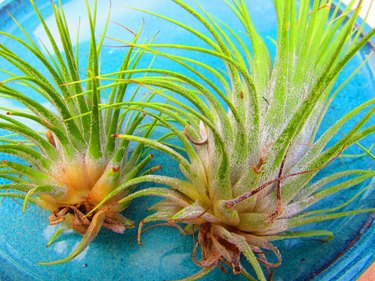
Most of us grow up thinking of plants as having leaves above the soil and roots beneath. Add a container and you've got a houseplant. That's why air plants can shock us. No roots searching for water? No soil? How can they be plants?
Air plants can be and are plants — easy-maintenance houseplants at that. They are different from any other houseplant you might have, but they are also extremely easy to take care of. Read up if you are tempted to add one to your collection.
Video of the Day
Video of the Day
Air Plant Highlights
Botanical name | Tillandsia spp. |
USDA zones | 9–13 |
Easy care? | Yes! |
Light/location | Indirect sun |
Growth rate | Slow |
Flowering? | Yes! Most grow flowers in white, red, pink, blue, purple, or yellow. |
Pet-safe? | Yes! |
All About Air Plants
Tillandsia air plants don't look like typical plants, but they are in fact plants — a type of plant called "epiphyte." Epiphytes do not uptake water and nutrients through their roots. Rather, these species use their roots to hold on to structures — often the branches of trees or large shrubs they grow on — and they collect their nutrients from the air around them and their water from the rain or humidity in the air.
The first time you see an air plant in the garden store, it may strike you as an alien form — something dropped from outer space. The leaves of the typical air plant grow in a spiraling rosette. They might be green, but don't count on it! They can also be silver, red, peach, or some other hue altogether, adding to their otherworldly character. And because they need no soil, these cute plants can be displayed in creative ways, like sitting on a desk or secured to a slab of bark.
So, what about the flowers? Most types of air plants will bloom, but only once in their life, putting out blossoms in bright, neon shades. The blooms usually signal the end of the plant's life cycle.

Mesic vs. Xeric Air Plants
Air plants are native to warm regions, including Central and South American rain forests and jungles and the high deserts of the American Southwest. It's important to know where your plant comes from since that will impact the type of care it needs.
Air plants that come from the jungle rain forests are called mesic, and they thrive in humid conditions. Those native to hot, dry regions in the American Southwest are called xeric. Most xeric air plants are silvery green and prefer drier conditions.

Types of Air Plants
Don't plan to flip a coin to select an air plant. There are more than 500 different types of air plants, and dozens of them are easily available in commerce. Here are five types of air plants that are gorgeous and easy to grow.
Sky Plant (Tillandsia ionantha)
The sky plant might be the most popular air plant, and it is among the easiest to care for, making it ideal for an air plant beginner. There is not one cultivar or two but dozens and dozens of ionantha cultivars, so pick one that appeals to you.
These plants have silver-green leaves when they are young, but they deepen in hue as the plant matures. When the sky plant is about to send out its yellow blossom, it's a color show! The leaves turn red and pink.
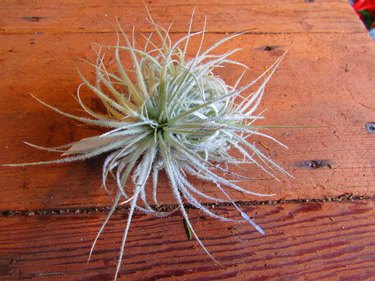
Peach Plant (Tillandsia capitata)
The peach plant is another good air plant for beginners, and it is one of the Tillandsias I see most in garden stores. It gets its common names from its oh-so-soft, peach-colored leaves. You can see it growing in the wild in Mexico or Cuba on rocky areas.
This classic air plant has leaves that grow in a rosette. The flower that ultimately emerges is a striking, twisting purple bloom. If you are determined to grow an air plant in direct sun, this one would be the most likely to survive. It can take direct sun or filtered sun.
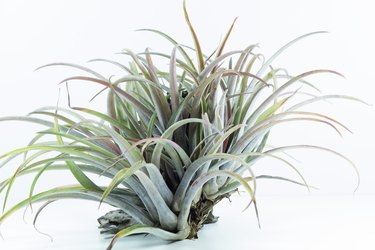
Pink Quill (Tillandsia cyanea)
The pink quill gets its common name from its showy pink quill-like foliage. Native to the Ecuador rain forests, it needs regular misting. Its flower is a beautiful violet. This is the only air plant I have ever seen growing in soil, so that's possible.
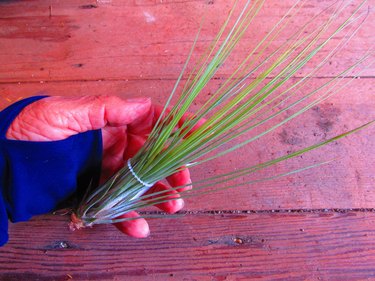
Fuchsii (Tillandsia Fuchsii v. Gracillis)
The Fuchsii air plant is also called the globe air plant since it matures into a perfect sphere. However, on its way there, this Tillandsia starts out with a central ball shape completely surrounded by its mass of soft, fuzzy leaves that look like thin, spiky "arms." The Fuchsii will develop one spike that produces a red and pink flower.
This is not a delicate plant, but it needs a healthy amount of water, so I recommend soaking it rather than relying solely on misting.

Funckiana (Tillandsia funckiana)
The Funckiana is one of the longer air plants. It is long and twisting, with thin, spiky leaves that look like they belong on a pine tree. Just before flowering, the leaves turn yellow. The flower is orange or red. Although it's sad when this beauty comes to the end of its life, it produces lots of pups. It needs bright light and adequate water to bloom.
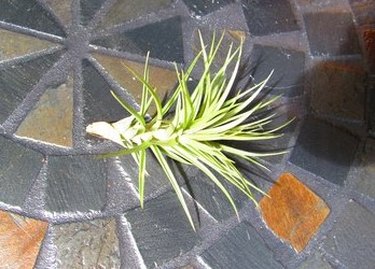
How to Care for Air Plants
The rules for caring for air plants are fairly simple:
- Indirect sun
- Warm, humid location
- Misting and submersion in water
Best Location for Air Plants
Site an air plant where it gets bright, indirect sun. Too much direct sun will scorch and kill the plants.
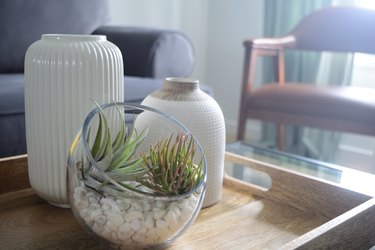
Potting Soil for Air Plants
Air plants don't need soil. Do not consider planting them in soil.
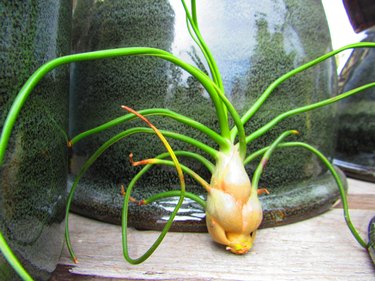
Containers for Air Plants
There's no need for a container for your air plants. You can display them attached to a support, like a slice of bark, or positioned on a seashell or saucer. Some people simply set them on a shelf or desktop.

Temperature and Humidity for Air Plants
As long as you keep your home a comfortable temperature for yourself, your air plant will also be warm enough. But you'll need extra humidity for mesic air plants.
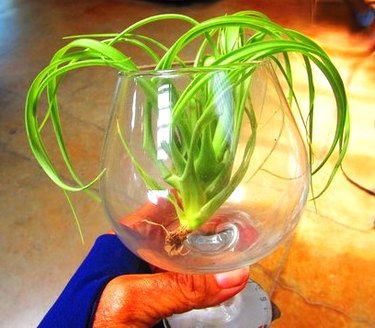
Water for Air Plants
All plants need water, and air plants have special water requirements. Their leaves have scales that absorb moisture from the air, but that only works in truly humid areas. In a place that isn't rain-forest humid, using a water misting bottle regularly is essential.
If you have a xeric air plant, several good mistings per week will provide adequate water for the plant. For mesic air plants, add to that misting a routine submersion in lukewarm water once or twice a week. Leave the plant under water for up to an hour. Shake off the plant when you take it out and let it dry upside down on a paper towel.
How can you tell if your plant is getting enough water? Keep an eye on the leaves. If you see them curling more than what's normal, they are thirsty. If the tips are brown, they are very thirsty. You will find that green leaves need more drinks than silvery leaves.

Fertilizer for Air Plants
Air plants may or may not need fertilizer. Mine seem to thrive without fertilizer, but my friends add a special fertilizer for Tillandsias to the misting or soaking water a couple times a month.

How to Prune Air Plants
You may not need to prune your air plants. These plants can be self-pruning since they naturally drop their outer or base leaves as new growth comes in. But sometimes, they don't drop these leaves, and you have to pull them off gently.
How to Propagate Air Plants
The best way to propagate Tillandsia epiphytic plants is by using the pups of the parent plant. Once the plants flower, they start to die. Part of the process is sending out offshoots that can grow into new adult plants.
There can be as many as eight pups. Once they get to a third of the size of the parent plant, they can survive on their own. Remove them carefully to create individual plants or leave them in an attractive clump.